Discover the Architectural Wonders of Dali Three Pagodas
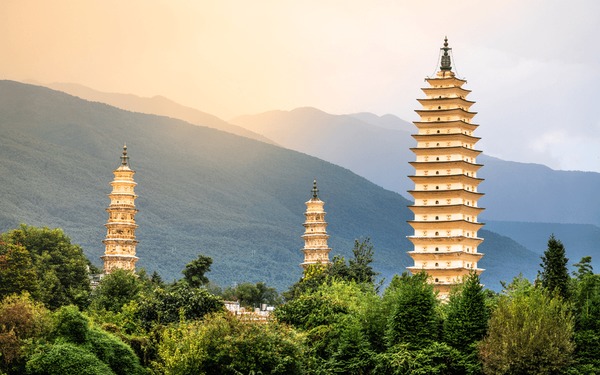
An Essential Guide to Visiting Dali Three Pagodas
Nestled amidst the breathtaking landscapes of Yunnan Province, the Dali Three Pagodas are not just architectural marvels; they are a bridge to the rich tapestry of Chinese history and culture. Towering against the majestic backdrop of Cangshan Mountain and overlooking the serene waters of Erhai Lake, these ancient structures have stood the test of time for over a millennium. Originally part of the Chongsheng Temple complex, they serve as enduring symbols of the region’s Buddhist heritage and architectural prowess.
As you stand beneath the impressive Qianxun Pagoda, the tallest and oldest of the trio, you can almost feel the whispers of the past—the legends of water spirits subdued, the echoes of deep spiritual practices, and the resilience of a culture that has thrived against the odds. The elegance of Tang and Song Dynasty architecture is on full display with the intricate details of each pagoda, inviting travelers to explore their secrets and stories.
Visiting the Three Pagodas is more than just a sightseeing excursion; it’s an immersive experience that connects you to the essence of Dali, a place where nature and history harmoniously intertwine. Whether you are a history buff, a photography enthusiast, or simply in search of serenity, the Three Pagodas offer an unforgettable journey into the heart of Yunnan’s cultural landscape. Prepare to be enchanted as you embark on this essential adventure through one of China’s most iconic landmarks.
In This Guide
- An Essential Guide to Visiting Dali Three Pagodas
- The Rich History and Legends of Dali Three Pagodas
- Main Highlights: What You Absolutely Can’t Miss
- Planning Your Visit: A Practical Guide
- Tickets: Prices, Booking, and Tips
- How to Get There: A Complete Transportation Guide
- Local Cuisine and Accommodation Nearby
- Frequently Asked Questions
- Final Thoughts on Your Trip
The Rich History and Legends of Dali Three Pagodas
The Dali Three Pagodas, known as the Three Pagodas of Chongsheng Temple, stand as enduring sentinels of history and culture in Yunnan Province. Built over a millennium ago, these architectural masterpieces are not only remarkable for their aesthetic appeal but also for their deep-rooted significance in local folklore and Buddhist traditions.
The oldest of the trio, the Qianxun Pagoda, dates back to the latter period of the Nanzhao Kingdom, around 800 AD. This storied structure reaches an impressive height of about 70 meters and is the tallest among the three. Its construction was inspired by a local legend that tells of devastating water disasters plaguing Dali, believed to be caused by mischievous water spirits. In a bid to quell these calamities, the local populace erected the Qianxun Pagoda, with a golden-winged bird statue perched atop it, thought to possess the power to control malevolent forces.
Adjacent to the Qianxun Pagoda are two smaller octagonal towers built during the Dali Kingdom era, which followed the Nanzhao period. These pagodas, while less imposing in stature, are equally rich in history and intricate design, reflecting the architectural advancements of the Song Dynasty. Together, they have withstood numerous earthquakes, a testament to their robust construction and the skill of ancient artisans.
The pagodas are part of the Chongsheng Temple complex, which was once a lavish royal sanctuary and a vital center for Buddhist culture in the region. During its zenith, the temple housed over 800 Buddhist chambers and an astonishing collection of 10,000 Buddha statues, earning Dali the title of the “Land of Fragrant Buddhas.” This cultural hub not only attracted pilgrims from across China but also served as a point of convergence for Buddhist practices from Southeast Asia.
While the original structure of Chongsheng Temple faced destruction over the centuries, including devastation from fires and earthquakes, it has since been meticulously reconstructed, allowing visitors to appreciate its former glory. Today, the temple continues to thrive as a spiritual center, drawing those interested in Buddhist teachings and practices.
The Three Pagodas, with their rich historical tapestry and legends, offer more than just a glimpse into the past; they embody the resilience and spiritual heritage of Dali. As you stand before these towering structures, you can’t help but feel a connection to the myriad of stories that have unfolded in their shadows throughout the ages, making them a must-visit for any traveler seeking to uncover the profound history of this enchanting region.
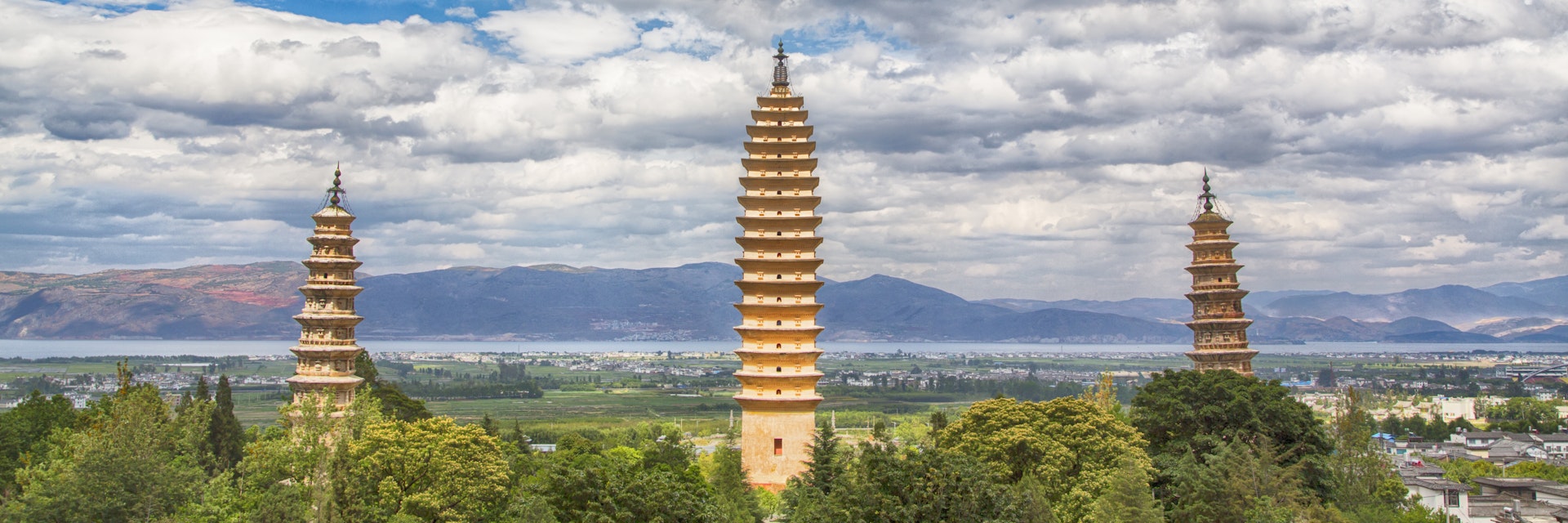
Dali Three Pagodas.
Main Highlights: What You Absolutely Can’t Miss
The Dali Three Pagodas, an iconic symbol of Yunnan province, stand as a breathtaking testament to ancient architectural brilliance and rich Buddhist heritage. Nestled against the majestic backdrop of Cangshan Mountain and overlooking the serene waters of Erhai Lake, these pagodas are not only a feast for the eyes but also a journey into history. Here’s what you absolutely can’t miss while exploring this remarkable site.
The Majestic Three Pagodas
Qianxun Pagoda
The tallest and oldest of the trio, the Qianxun Pagoda rises to approximately 70 meters and dates back over 1,200 years. This impressive structure features 16 stories and is a prime example of Tang Dynasty architecture. Its unique design includes a hollow interior, which adds to its historical intrigue. Standing beneath the pagoda, you can truly appreciate its grandeur and the resilience it has shown, surviving numerous earthquakes while still maintaining its impressive stature.
The Flanking Pagodas
On either side of the Qianxun Pagoda are two smaller octagonal pagodas, each with ten levels and showcasing exquisite details reflective of the Song Dynasty’s architectural style. These pagodas complement the grandeur of the central structure and provide a striking contrast against the backdrop of Cangshan Mountain.
Chongsheng Temple Complex
Chongsheng Temple
This ancient temple complex is a vital part of the Three Pagodas experience. Once a royal sanctuary for the Nanzhao and Dali Kingdoms, the temple symbolizes the deep-rooted Buddhist traditions of the region. As you wander through the temple grounds, you’ll encounter numerous artifacts, including the revered Yutong Guanyin statue. The temple’s architecture and spiritual atmosphere make it a must-visit for those interested in Buddhist culture.
Breathtaking Panoramic Views
Ascend to the Acoya Guanyin Pavilion within the temple complex for one of the best views in Dali. The panoramic vista includes sweeping views of Erhai Lake and the surrounding landscape, offering a perfect backdrop for photographs and quiet reflection.
Capture the Perfect Shot
Reflection Park
Don’t miss the opportunity to photograph the stunning reflections of the Three Pagodas in the nearby Reflection Park. The calm waters create a picturesque mirror effect, especially during the early morning or late afternoon when the light is softer. This is a classic spot for capturing the essence of Dali and is sure to be a highlight of your visit.
Architectural Marvels
Cultural Relics Exhibition Hall
Take some time to explore the Three Pagodas Cultural Relics Exhibition Hall, where you can learn more about the history and significance of the pagodas and the Chongsheng Temple. The exhibits provide fascinating insights into the region’s cultural heritage and architectural evolution.
Surrounding Attractions
Dali Ancient Town
Just a short distance from the Three Pagodas, Dali Ancient Town is a charming historic district where you can wander through narrow streets, browse local shops, and admire the traditional Bai architecture. This area beautifully complements your visit to the pagodas and offers a glimpse into the local culture.
Erhai Lake
A visit to the Three Pagodas wouldn’t be complete without experiencing the stunning Erhai Lake. Enjoy a leisurely bike ride along the lakeside or take a boat cruise to appreciate the natural beauty that surrounds this iconic landmark.
Conclusion
The Dali Three Pagodas and the Chongsheng Temple complex offer a unique blend of history, architecture, and spirituality. From the towering Qianxun Pagoda to the tranquil views of Erhai Lake, every moment spent here is an invitation to connect with the past while enjoying the stunning beauty of Yunnan province. Make sure to allocate ample time to soak in all that this remarkable site has to offer!
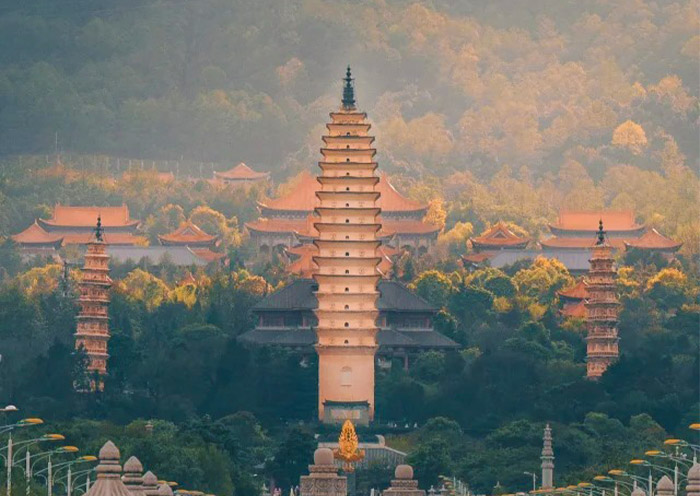
Dali Three Pagodas.
Planning Your Visit: A Practical Guide
Planning Your Visit: A Practical Guide to Dali Three Pagodas
Visiting the Dali Three Pagodas, a significant cultural and architectural landmark in Yunnan, is an experience that combines history, spirituality, and breathtaking natural beauty. Here’s everything you need to know for a seamless visit to this iconic site.
Getting There
Location: The Three Pagodas are situated approximately 1.5 kilometers northwest of Dali Ancient City, surrounded by the majestic Cangshan Mountain and Erhai Lake.
Transportation Options:
– Public Transport: Buses run frequently from Dali Ancient City to the Three Pagodas, taking about 25-30 minutes.
– Taxi/Ride-Sharing: A taxi ride will only take you around 10-15 minutes.
– Biking: Rent a bicycle or an electric bike in Dali Ancient City for a scenic 15-minute ride to the pagodas.
– Walking: For those who enjoy a leisurely stroll, it’s a pleasant 40-minute walk that allows you to soak in the local atmosphere.
Best Time to Visit
The ideal time to explore the Three Pagodas is during the spring (April to June) and autumn (September to November) months, when the weather is mild and the surrounding landscapes are particularly stunning. Early mornings or late afternoons provide softer lighting for photography and a less crowded experience.
Entrance Fees and Hours
- Admission Fee: 110 RMB (includes access to electric carts).
- Opening Hours: Daily from 08:00 AM to 05:30 PM.
Recommended Itinerary
To maximize your experience, consider the following route:
- Three Pagodas: Start with the main highlight, where you can admire the towering structures and learn about their rich history.
- Reflecting Pool: Just a short walk away, capture stunning views of the pagodas reflected in the water.
- Three Pagodas Cultural Relics Exhibition Hall: Dive deeper into the history and significance of the site.
- Chongsheng Temple: Explore this tranquil temple complex that offers insights into the region’s Buddhist traditions.
- Yutong Guanyin Hall and Main Buddha Hall: Marvel at the intricate architecture and spiritual artifacts.
- Acoya Guanyin Pavilion: Climb to the highest point for breathtaking panoramic views of Erhai Lake and the surrounding landscape.
The entire visit will take about 2 hours, but feel free to linger longer at spots that captivate you.
Additional Attractions Nearby
Enhance your trip by visiting these nearby sites:
- Dali Ancient Town: A short distance away, this historic town features charming streets, local shops, and traditional Bai architecture.
- Erhai Lake: Perfect for cycling, boating, or simply enjoying the scenic views, this freshwater lake is a must-see in the area.
- Cangshan Mountain: Explore hiking trails with stunning vistas that complement your visit to the pagodas.
Tips for a Memorable Visit
- Photography: Early morning or late afternoon light is perfect for capturing the pagodas and their reflections. Don’t miss the Three Pagodas Reflection Park for iconic photos.
- Dress Comfortably: Wear comfortable shoes, as you will be walking and exploring the temple complex.
- Respect Local Culture: As a significant Buddhist site, be mindful of the local customs and dress appropriately when visiting the temples.
Conclusion
With its rich history, stunning architecture, and serene surroundings, the Dali Three Pagodas are more than just a destination; they are a journey into the heart of Yunnan’s cultural heritage. By planning ahead and embracing the local atmosphere, your visit will be both enriching and unforgettable.
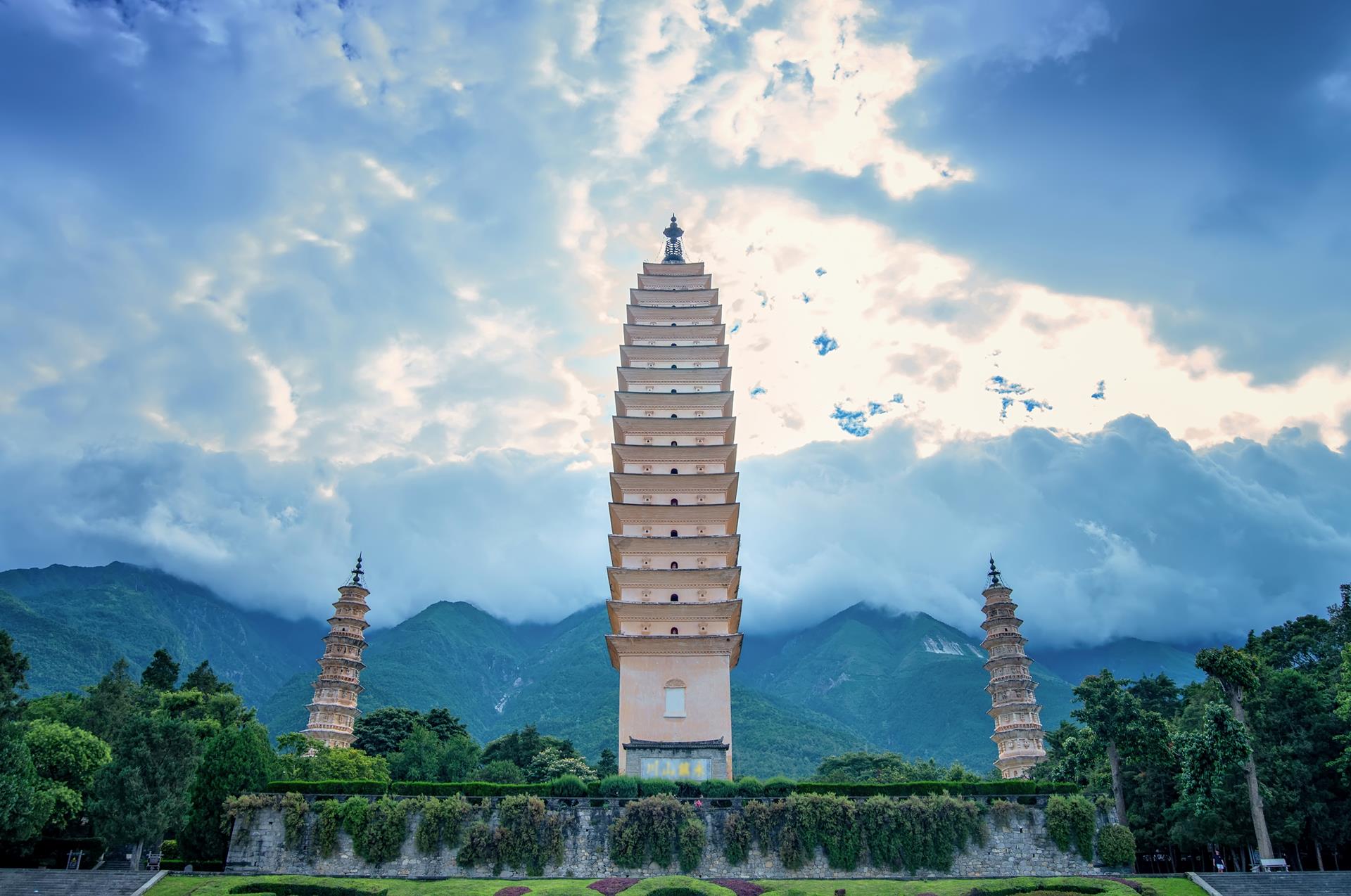
Dali Three Pagodas.
Tickets: Prices, Booking, and Tips
Visiting the Dali Three Pagodas is an enriching experience that immerses you in the historical and cultural tapestry of Yunnan Province. Here’s everything you need to know about tickets, prices, booking, and some handy tips for your visit.
Ticket Information
-
Entrance Fee: The ticket price for accessing the Three Pagodas and Chongsheng Temple complex is 110 RMB. This fee includes the use of electric carts, which can be quite convenient for navigating the sprawling grounds.
-
Opening Hours: The site is open daily from 08:00 AM to 05:30 PM. Arriving early is advisable to enjoy the serene atmosphere before larger crowds arrive.
Booking Your Tickets
Tickets can be purchased on-site at the entrance of the Three Pagodas. However, during peak tourist seasons, it’s wise to arrive early to secure your entry, as the site can get busy. If you prefer convenience, consider booking through local travel agencies or online platforms that offer guided tours, which may include skip-the-line access.
Tips for Your Visit
-
Best Time to Visit: To fully appreciate the beauty of the Three Pagodas and avoid the midday heat, plan your visit either early in the morning or later in the afternoon. These times also provide softer lighting for photography, especially with the stunning reflections in nearby Erhai Lake.
-
Photography: Don’t miss the chance to capture the pagodas from various angles. The Three Pagodas Reflection Park, located about 1 kilometer south of the pagodas, offers a perfect spot for stunning reflections. Early morning or late afternoon light can create magical photo opportunities.
-
Transportation: The pagodas are approximately 2.5 kilometers from Dali Ancient City. You can reach them via public bus (25-30 minutes), taxi (10-15 minutes), or rent a bicycle for a scenic ride (around 15 minutes). If you enjoy walking, it’s a leisurely 40-minute stroll.
-
Explore the Surroundings: After visiting the pagodas, consider exploring the nearby Dali Ancient Town and Erhai Lake. Both locations offer a glimpse into the local culture and beautiful landscapes.
By following these tips and securing your tickets, your visit to the Dali Three Pagodas will be not only seamless but also incredibly memorable. Enjoy your journey through history and culture in this breathtaking part of Yunnan!
How to Get There: A Complete Transportation Guide
To explore the Dali Three Pagodas (大理三塔), an iconic landmark in Yunnan, you’ll need to navigate the transportation options available to get there. Below is a comprehensive guide to help you plan your journey seamlessly.
Getting to Dali Three Pagodas
Location
The Three Pagodas of Chongsheng Temple are located approximately 1.5 kilometers northwest of Dali Ancient City, making them easily accessible for visitors staying in the area.
From Dali Ancient City
Public Transportation
- Bus: The most economical option is to take a public bus from Dali Ancient City to the Three Pagodas. This typically takes around 25 to 30 minutes. Buses run frequently, so you won’t have to wait long.
- Taxi/Ride-Sharing: For a quicker option, you can catch a taxi or use a ride-sharing app, which will take about 10 to 15 minutes. This is ideal if you’re traveling in a group or prefer a more direct route.
Self-Cycling
- For those who enjoy a bit of adventure, renting a bicycle or an electric bike from Dali Ancient City is a fantastic way to reach the Three Pagodas. The ride takes approximately 15 minutes, allowing you to soak in the scenic views along the way.
Walking
- If you’re keen to immerse yourself in the local atmosphere, consider walking to the Three Pagodas. The leisurely stroll is about 40 minutes long and provides a great opportunity to enjoy the sights and sounds of Dali.
Exploring the Area
Once you arrive at the Three Pagodas, you’ll find that the site is quite expansive and can be explored in several ways:
- On Foot: The Chongsheng Temple complex and the pagodas themselves are best explored on foot. Wandering around will allow you to appreciate the intricate details of the architecture and discover smaller temples within the complex.
- Electric Carts: For those who prefer a more relaxed exploration, electric carts are available for rent within the scenic area. This option is particularly useful if you wish to cover more ground without walking long distances.
Tickets and Admission
- Entrance Fee: The entrance fee to the Three Pagodas and Chongsheng Temple is 110 RMB, which includes access to the electric carts.
- Opening Hours: The site is open daily from 8:00 AM to 5:30 PM, giving you ample time to visit and explore.
Nearby Attractions
In addition to the Three Pagodas, consider visiting the following attractions that are easily accessible:
– Dali Ancient Town: Just a short distance away, this historic district offers a glimpse into the region’s rich cultural heritage with its narrow streets and traditional Bai architecture.
– Erhai Lake: A stunning freshwater lake located close to the pagodas, perfect for leisurely walks or cycling trails.
Final Tips
- Best Time to Visit: Early morning or late afternoon provides the best lighting for photography, especially for capturing the reflection of the pagodas in the nearby pools.
- Plan Your Route: Consider starting your visit at the Three Pagodas, then making your way to the Reflecting Pool and the Chongsheng Temple for a full experience of this magnificent site.
With this guide in hand, you’re ready to embark on your journey to the Dali Three Pagodas, where history, culture, and stunning natural beauty await!
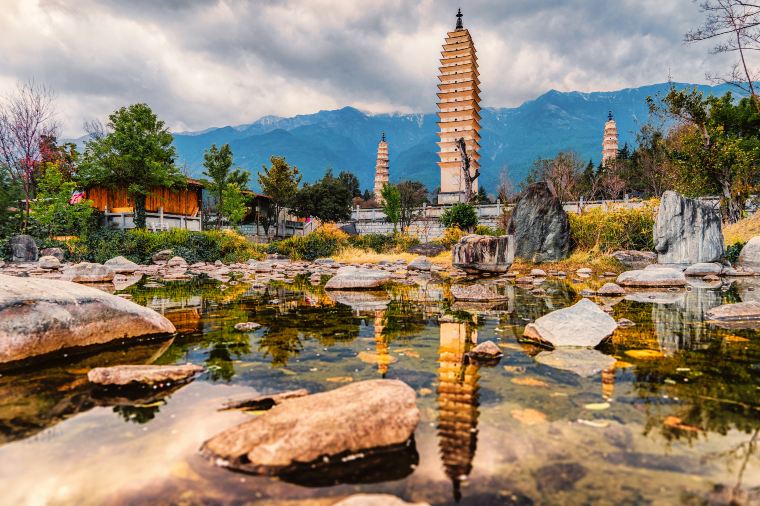
Dali Three Pagodas.
Local Cuisine and Accommodation Nearby
When visiting the majestic Dali Three Pagodas, you’ll want to immerse yourself in the local culture, which includes savoring the delightful cuisine and finding a comfortable place to stay. Fortunately, the area surrounding the pagodas boasts a variety of eateries and accommodations that cater to international travelers.
Culinary Delights
1. Bai Cuisine
Dali is renowned for its unique Bai ethnic cuisine, characterized by fresh ingredients and robust flavors. Don’t miss the chance to try the local specialty, Crossing-the-Bridge Noodles (过桥米线), a delicious dish featuring rice noodles served in a rich broth alongside an array of fresh vegetables and meats. The Dali Bridge Noodles Restaurant near the pagodas is a popular spot among tourists and locals alike.
2. Erhai Fish
Savor the taste of Erhai Lake with Erhai Fish, typically grilled or cooked in a spicy broth. Dali Fish Restaurant, located just a short distance from the Three Pagodas, offers a cozy atmosphere and authentic dishes that highlight the region’s freshwater bounty.
3. Traditional Snacks and Street Food
For a quick bite, explore the streets around Dali Ancient Town, where food stalls serve delectable snacks like Bai-style dumplings and grilled mushrooms. Dali Ancient Town Food Street is an ideal location to sample these treats, while soaking in the vibrant local scene.
4. Cafés with a View
If you’re looking for a delightful place to relax with a cup of coffee or tea, Café Tuo offers stunning views of the Three Pagodas. Enjoy their latte art alongside homemade pastries for a refreshing break.
Comfortable Stays
1. The Three Pagodas Hotel
Just a stone’s throw from the Three Pagodas, this hotel offers comfortable accommodations with stunning views of the pagodas and Cangshan Mountain. The hotel features modern amenities, a restaurant serving local cuisine, and easy access to the temple complex.
2. Dali Ancient Town Boutique Inn
For a more traditional experience, consider staying at one of the boutique inns in Dali Ancient Town, such as The Bai House. With its charming architecture and personalized service, this inn provides a cozy atmosphere perfect for relaxation after a day of exploration.
3. Erhai Lake Resort
If you prefer a lakeside retreat, the Erhai Lake Resort is an excellent choice. Located a short distance from the pagodas, this resort offers luxurious accommodations with stunning lake views, a swimming pool, and spa services for ultimate relaxation.
4. Hostel Options
For budget travelers, Dali No. 1 Hostel is a popular choice. This friendly and social hostel offers dormitory-style accommodations and private rooms, along with a communal area where you can meet fellow travelers and share experiences.
In Summary
Whether you’re indulging in the local flavors or enjoying a restful night near the Dali Three Pagodas, the area offers a rich tapestry of culinary and accommodation options that will enhance your visit. Be sure to explore and savor every moment in this beautiful part of Yunnan!
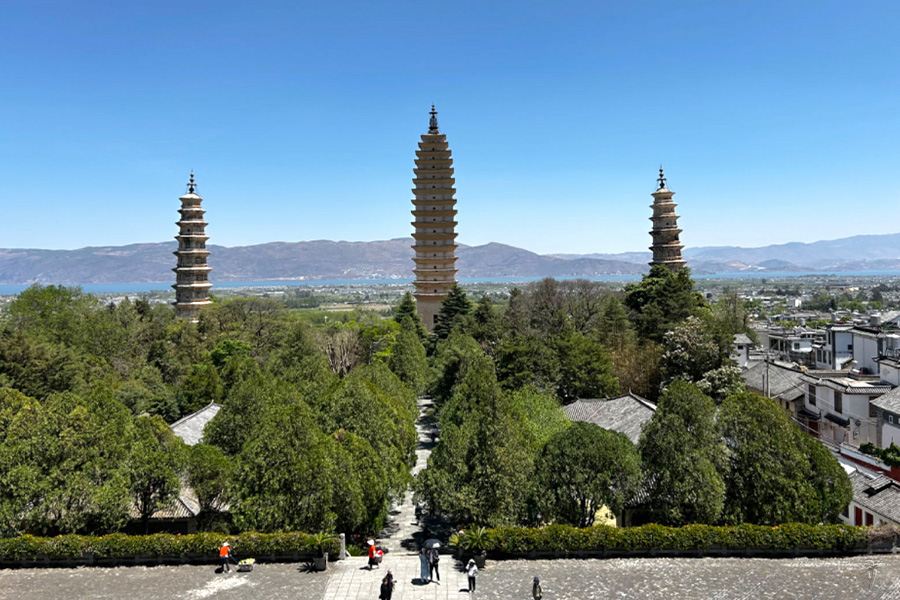
Dali Three Pagodas.
Frequently Asked Questions
Frequently Asked Questions about Dali Three Pagodas
1. What are the Dali Three Pagodas, and why are they significant?
The Dali Three Pagodas, located at the Chongsheng Temple complex, are iconic structures that date back over 1,200 years. They represent the architectural and cultural heritage of the region, showcasing the Buddhist traditions of Yunnan. The pagodas have withstood numerous earthquakes, symbolizing resilience and the enduring spirit of the local community.
2. How do I get to the Three Pagodas from Dali Ancient City?
The Three Pagodas are approximately 2.5 kilometers northeast of Dali Ancient City. You can reach them by public bus (25-30 minutes), taxi (10-15 minutes), or by renting a bicycle for a scenic ride (about 15 minutes). Walking is also an option, taking around 40 minutes to enjoy the local atmosphere.
3. What is the entrance fee for visiting the Three Pagodas?
The entrance fee to the Three Pagodas and Chongsheng Temple is 110 RMB. This ticket includes access to the site and the use of electric carts available for rent within the scenic area.
4. What are the best times to visit the Three Pagodas?
The best times to visit are early morning or late afternoon when the lighting is softer for photography and the temperatures are more comfortable. Additionally, visiting during weekdays can help you avoid larger crowds.
5. Can I take photographs at the Three Pagodas?
Absolutely! The Three Pagodas are a photographer’s dream. Be sure to capture them from various angles and especially from the nearby Reflecting Pool, where you can get stunning reflections. Early morning or late evening provides the best lighting conditions for your shots.
6. What should I wear when visiting the Three Pagodas?
Comfortable walking shoes are recommended, as you’ll be exploring a large area. Dress in layers, as temperatures can vary throughout the day. If you plan to enter the temple areas, modest clothing is appreciated as a sign of respect for the sacred space.
7. Are there any nearby attractions I should visit?
Yes! After exploring the Three Pagodas, consider visiting Dali Ancient Town, known for its charming streets and traditional Bai architecture. Erhai Lake is another must-see, where you can enjoy cycling, boating, or simply relaxing by the water.
8. Is there public transportation available to explore the area around the Three Pagodas?
Yes, public buses and taxis are readily available in Dali for transportation to and from the Three Pagodas. Within the area, you can also use electric carts for easier navigation around the larger Chongsheng Temple grounds.
Final Thoughts on Your Trip
As your journey through the enchanting Dali Three Pagodas comes to a close, take a moment to reflect on the rich tapestry of history and culture that surrounds you. These ancient towers, standing resolute against the backdrop of the magnificent Cangshan Mountain and the serene waters of Erhai Lake, are not just architectural marvels; they embody the spirit of resilience and devotion that has characterized this region for over a millennium.
Whether you stood in awe beneath the towering Qianxun Pagoda, explored the tranquil grounds of the Chongsheng Temple, or captured the perfect photograph of the pagodas reflecting in the water, each experience adds depth to your understanding of Yunnan’s Buddhist heritage. The stories whispered by the winds around these sacred structures invite you to delve deeper into the local culture and traditions.
As you venture beyond the pagodas, the allure of Dali continues to beckon. From the charming streets of Dali Ancient Town to the tranquil shores of Erhai Lake, every corner of this region offers a new adventure waiting to be discovered. Embrace the warmth of the Bai culture, savor the local flavors, and cherish the breathtaking landscapes that make Dali a destination like no other.
Your visit to the Three Pagodas is more than just a stop on your travel itinerary; it’s a journey into the heart of a place where history, nature, and spirituality converge. Carry these memories with you, and let them inspire your future travels as you share the wonders of Dali with friends and family. Safe travels!